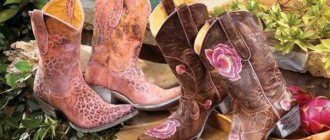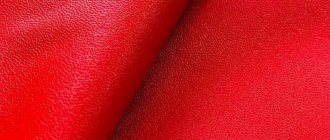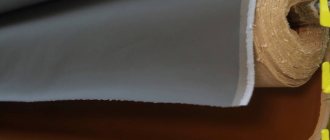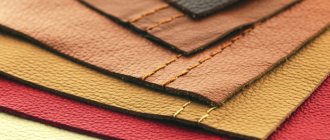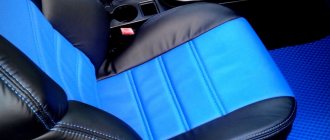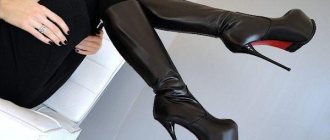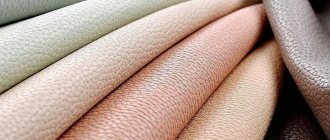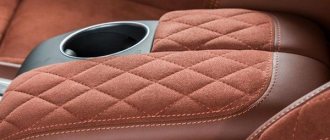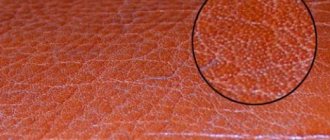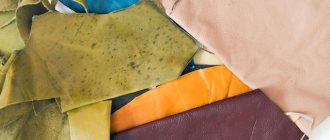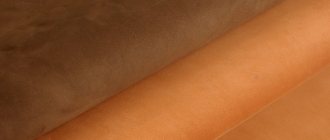Many people are interested in which material is better: eco-leather or artificial leather. Some say that the question should not be asked this way, because it is the same thing. Others argue that these are different materials, and leatherette is fundamentally different from eco-leather. How are things really going?
Let's start with the fact that these are really different materials. But they have something in common. They are synthetic and designed to replace natural leather. However, there are extremely many differences between them.
Eco-leather or artificial leather, which is better?
Leatherette began to be produced in the middle of the 20th century. Its basis is fabric-reinforced PVC sheets. During the production process, plasticizers and stabilizers are used, due to which the material has an unpleasant chemical odor and releases toxic substances when heated.
Eco-leather began to be produced at the beginning of the 21st century. Its base is cotton or polyester, sometimes with the addition of pressed leather shavings. On which polypropylene is applied. This is an environmentally friendly substance compared to polyvinyl chloride. To obtain a material that looks like leather, you do not need to use plasticizers and stabilizers.
The production method and composition are the first differences between eco-leather and leatherette. But this is not the only difference between these two materials. By changing the film coating, eco-leather has acquired properties that bring it closer to natural leather. The resulting fabric became porous. The pore size is such that moisture is removed from the body without compromising the waterproofness of the material. Due to the heterogeneous structure, eco-leather allows air to pass through.
The woven base of eco-leather makes it elastic. Clothes made from it fit better, and shoes are more practical to wear.
The difference between the two materials is their structure. Eco-leather is essentially a fabric base on which a polypropylene film is applied. That is, the material is closer to ordinary fabrics. In percentage terms, it consists of only 25% polymer, and 75% cotton or polyester. Faux leather consists of sheets of polyvinyl chloride held together with a woven backing. The material consists of 70% polymers and plasticizers.
The production of artificial leather without PVC is environmentally friendly. It does not harm the environment as no toxic substances are used. The material is harmless to humans.
The answer to the question of which is better eco-leather or artificial leather is the first option. Since the material is environmentally friendly, it has the best consumer qualities.
What is the difference between the materials?
Not everyone understands the difference between eco-leather and leatherette - many buyers mistakenly believe that they are the same thing. This is a wrong opinion; we are talking about two different materials that should be compared with each other. Let's try to identify the difference?
The first difference between eco-leather and leatherette stems from the similarities. Both materials are produced in the same way - they are based on fabric or synthetic fabric, which is covered with a film coating that does not allow water to pass through. This is where the difference begins!
- The artificial fabric is coated with polyurethane, which “does not breathe”;
- The eco-friendly material is coated with polyvinyl chloride (PVC), a more natural and breathable material.
We will not dwell on the first point - we will continue to explore the difference between eco-leather and leatherette.
| Eco leather | Leatherette |
| It has increased strength and can last up to 5-10 years with careful use | Strength is low - wears out within a year or two |
| Pleasant to the touch, warms from the human body, and is soft | Cold and rather rough material, contact with it is unpleasant |
| Freely allows air flow in both directions | Doesn't allow air to pass through at all |
| Hypoallergenic material that does not cause irritation | May cause allergic reactions |
| Environmentally friendly fabric without harmful impurities | Manufactured with the addition of harmful synthetic materials |
| Calmly withstands cold without changing appearance or performance properties | At low temperatures it cracks and breaks, becomes rough |
Finally, we’ll tell you how leatherette differs from eco-leather in appearance - sometimes you can tell the difference at first sight!
- Eco-fabric is practically indistinguishable from genuine leather; it has a smooth, even structure;
- Leatherette looks rougher, the structure is slightly textured.
We have looked at the main differences and differences between the two types of material - it’s time to look for the difference with your own eyes and hands. Catch interesting ways to find the right canvas!
Learn how to remove yellow spots under arms in 2 minutes.
Advantages and disadvantages of eco-leather
Artificial leather without PVC has undeniable advantages over its predecessor and can even compete with natural leather. Advantages of high-tech material:
- strength - it is difficult to tear, it is resistant to friction, unlike leatherette;
- high hygienic indicators - the fabric is breathable, it allows air to pass through to the body and removes moisture from it. Due to this, a sauna effect is not created;
- resistance to low temperatures - the material does not crack in the cold, does not harden;
- hypoallergenic - does not cause irritation for people with sensitive skin. This property distinguishes eco-leather from natural and artificial leather;
- UV resistance - the fabric does not deteriorate under the influence of sunlight and does not fade;
- elasticity and elasticity - the fabrics stretch, but do not deform, clothes do not stretch on the knees or butt;
- water resistance - the fabric does not allow water to pass through;
- rich palette - the material lends itself well to painting in bright colors.
Eco-leather is cheaper than natural leather, but its properties are not much inferior to it. And its production process is more environmentally friendly.
Types of genuine leather
There are several types of genuine leather. These include:
- Chevreau - natural chrome leather, made exclusively from goat or sheep skins, has a coarse-grained structure, increased softness and elasticity;
- Shagreen is a natural vegetable tanned leather made from the skins of sheep, donkey, horse and goat;
- Varnish - genuine leather with a glossy varnish coating, which gives the product additional strength and an unusual appearance;
- Suede is a natural leather made from the skins of deer, elk, and cattle.
there is patent leather, suede, shagreen and chevro
Advantages and disadvantages of artificial leather
In many respects, leatherette is inferior to eco-leather. Disadvantages of the material:
- does not allow air to pass through and does not remove moisture from the body - clothes and shoes made from it are uncomfortable due to the greenhouse effect;
- not resistant to low temperatures - the fabric becomes tanned and cracks;
- rougher than natural and artificial leather;
- has an unpleasant odor;
- releases toxic substances when heated;
- fades in the sun, and leatherette completely cracks;
- not elastic and less durable than non-PVC leather.
Artificial leather also has a number of advantages. This is a cheap material that is widely used for upholstery of office furniture, bus seats, and trams. It is available in a wide range of colors. The fabric does not allow water to pass through and is easy to care for.
If 20-30 years ago outerwear and shoes were made from artificial leather, now it is used for upholstery. Most often these are couches, trestle beds, chairs for medical institutions, public transport seats, furniture in inexpensive dining rooms.
Types of eco-leather
Eco-leather is a new type of leather substitute that has nothing in common with natural material, although many dishonest sellers claim the opposite. There are several main types of ecological leather. These include:
- Vinyl is an artificial material made using polyvinyl chloride, which gives the product additional strength, and to soften the material and elasticity, various plasticizers are usually added to the vinyl composition;
- Dermantin is an artificial material that has increased abrasion resistance and thermal resistance, mainly used for the manufacture of car seat covers.
eco-leather can be represented by dermantine and vinyl
How to distinguish leatherette from eco-leather when purchasing
Sometimes unscrupulous manufacturers pass it off as eco-leather - leatherette or leatherette. To recognize a fake, pay attention to the following points:
- The difference between eco-leather and artificial leather is that it is softer; the heat of the human body is transferred to it. Faux leather feels like plastic. It remains cold after contact with your hands;
- eco-leather stretches, but leatherette does not. When purchasing, lightly pull the edge of the product to check its elasticity;
- smell the product or piece of material. Eco-friendly leather smells almost the same as natural leather, it has a pleasant, slightly sweet smell. Leatherette, especially cheap ones, has an unpleasant, pungent chemical aroma.
If the item was given to you, then there is a way to distinguish eco-leather from artificial leather at home. For this you will need vegetable oil. Apply a drop onto an inconspicuous area of the product and rub in. After a day, examine the material. The eco-leather will absorb the oil without harming itself. The leatherette will become rough and hard to the touch.
Eco-leather is a new generation material. It combines the advantages of natural leather (hygroscopicity, breathability) and artificial leather (water resistance, low price). If we compare two analogues of natural material, the high-tech substitute wins in several respects. It is more pleasant to the touch, has high hygienic qualities, is elastic, and resistant to low temperatures.
Dear readers of the Tkan.Club website, if you still have questions on this topic, we will be happy to answer them. Leave your reviews, comments, share stories if you have dealt with this material! Your life experience may be useful to other readers.
Which is better to choose?
It’s not always possible to immediately figure out which is better – eco-leather or leatherette! Let's look at a few examples, shall we? If you are buying shoes, clothes or a bag, you should give preference to eco-leather:
- It allows the body to breathe;
- Retains moisture - you don’t risk getting wet;
- You don't have to worry about allergies;
- A high level of strength and wear resistance is guaranteed;
- The products are easy to care for.
In comparison with these characteristics, leatherette loses in all respects, winning on one point - a much lower price. If you often change bags, jackets or shoes, you can buy a substitute, it is much cheaper. You won't have to regret spending money if it doesn't matter what the quality is!
How to figure out which canvas to give preference to in furniture? The difference is obvious!
- If you are buying a sofa or chair for public places (for example, a reception room), you can choose leatherette. For little money you will get attractive furniture that will last for several years - and you practically don’t need to care for it;
- If you want to purchase furniture on which you will sit constantly, the choice should fall on eco-leather. The canvas is soft and pleasant to the body - you don’t have to sit on a cold, hard surface. In addition, it can easily withstand even intensive use.
We told you about the difference between eco-leather and artificial leather - were you surprised by the secrets revealed? Now you can choose the ideal material for furniture, clothing or other items that meets your wishes, comfort and safety! Read on to learn how to wash sneakers in a washing machine.
What is the difference between eco-leather and leatherette
No plasticizer additives are used in the production of eco-leather. Another feature in the production of ecological leather is a special attitude towards the base of the polyurethane film: the material does not experience various types of loads.
The result is that eco-raw materials acquire a flexible structure and elasticity. Polyurethane film occupies no more than 25% of the total mass. Therefore, we can safely say that eco-leather is a fabric impregnated with polyurethane. And for leatherette you can choose a definition: a sheet of polymer reinforced with fabric.
The breathability of eco-leather is significantly higher than that of other leatherettes. This was achieved due to the fact that during the film application process, pores are formed through which air and water vapor pass, but not the water itself. The polyurethane network is very mobile, so polymers can rearrange under the influence of mechanical loads and temperature changes. These abilities explain their resistance to wear and very low temperatures. The polymers of films of other types of artificial leather wear out faster and crack in severe frosts.
Reference! Polyurethanes can even eliminate damage to the polymer network during deformation due to the presence of special groups of atoms that natural leather has.
What should you consider when choosing a material?
So, to make it easier for you to decide on the choice of material from which you want to purchase a bag, answer the following questions for yourself before going to the store or online purchase:
- How much are you willing to spend on the purchase?
- How often will you wear this bag?
- Are you allergic to any particular material?
- For what purpose are you purchasing a bag - for evening outings or for every day, for heavy documents or for a light walk?
We wish you pleasant shopping with the Bag Empire!
Share:
What do the materials look like?
The above-mentioned products are used for the manufacture of things for all kinds of purposes: home furniture upholstery, car covers, clothing items, as well as accessories in the form of handbags and wallets. Example of using eco-leather:
Eco leather covers
And this is a product made of artificial leather of a different type:
Leatherette jacket
